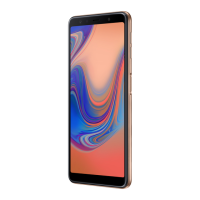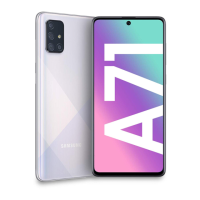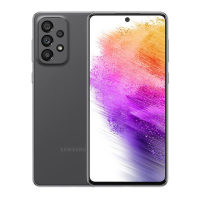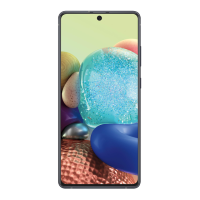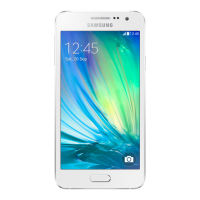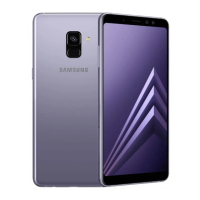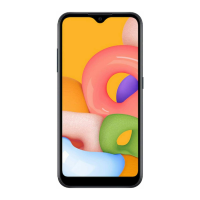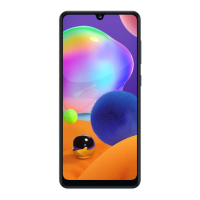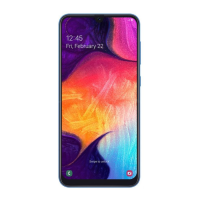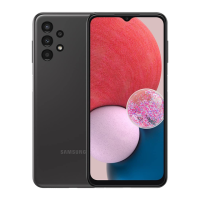Do you have a question about the Samsung Galaxy A70 and is the answer not in the manual?
Guidance on safe and proper device usage, including content differences and software liability.
Explanation of warning, caution, and notice icons used in the manual.
Information on device heating during charging and solutions.
Overview of device components, package contents, and hard/soft keys.
Instructions for charging, reducing consumption, and battery tips.
Guide to installing and removing SIM/USIM cards and microSD cards.
Steps for powering on, off, and restarting the device.
Guide to initial device setup and registering a Samsung account.
Methods for transferring data from previous devices using Smart Switch.
Information on touchscreen control, gestures, and navigation bar.
Guide to installing, uninstalling, and managing apps and permissions.
Introduction, setup, and usage of Bixby for voice commands and assistance.
Using Bixby Vision for image recognition, translation, and AR experiences.
How to create reminders and manage events in the Calendar app.
Making calls, managing contacts, blocking numbers, and call options.
Sending, viewing, and blocking messages, and setting notifications.
Browsing webpages, using secret mode, and managing internet security.
Taking photos, recording videos, and using various camera modes and features.
Viewing images and videos, creating stories, sharing albums, and syncing media.
Creating personalized AR Emojis, stickers, and capturing photos/videos.
Configuring the Always On Display for information and music control.
Using split screen and pop-up view to run multiple apps simultaneously.
Setting up Kids Home for children, including parental controls and playtime.
Setting up and making payments with Samsung Pay and Samsung Pay mini.
Creating notes and managing calendar events, including reminders.
Using Samsung Health for fitness tracking, step goals, and health tips.
Recording voice memos and managing device files.
Setting alarms, world clocks, stopwatch, and timers.
Managing games, performance modes, and in-game features.
Connecting and controlling nearby devices, home appliances, and IoT products.
Sharing content via various methods, including large files and Smart View.
Overview of Google apps like Chrome, Gmail, Maps, and Drive.
Configuring Wi-Fi, Bluetooth, NFC, mobile networks, and tethering.
Adjusting sound modes, ringtones, notification sounds, and Dolby Atmos.
Managing notification settings, Do Not Disturb, and app icon badges.
Adjusting brightness, screen modes, blue light filter, and screensavers.
Customizing lock screen, screen lock methods, and Smart Lock.
Setting up face recognition, fingerprints, Samsung Pass, and Secure Folder.
Managing accounts, backing up data with Samsung Cloud, and using Smart Switch.
Activating and configuring features like Dual Messenger, Game Launcher, and SOS messages.
Monitoring device usage, setting app timers, and activating wind down mode.
Checking device status, optimizing performance, and managing battery, storage, and memory.
System settings, language, date/time, reset options, and accessibility features.
Information on updating device software and security patches.
Accessing the user manual and viewing device information.
Explanation of Password, PIN, PUK, and PIN2 prompts.
Troubleshooting for touchscreen issues and device freezes.
Resolving issues with call connections, network reception, and audio quality.
Solutions for battery charging issues, depletion, camera errors, and photo quality.
Resolving issues with multimedia files and Bluetooth connections.
Troubleshooting computer connection failures and lost device data.
Resolving issues with Home screen buttons, Bixby, and Samsung Cloud.
Critical warnings about electrical safety, power cords, and approved accessories.
Precautions for handling, storing, and protecting the device from damage and hazards.
Information on RF interference, pacemakers, and health risks.
Safety guidelines for using the device in vehicles and potentially explosive environments.
Guidelines for device care, temperature, and preventing repetitive motion injuries.
Tips to protect against malware, viruses, and ensure data security.
Special precautions, ISED compliance, SAR information, and disposal guidelines.
| Screen shape | Flat |
|---|---|
| Pixel density | 393 ppi |
| Display diagonal | 6.7 \ |
| Touch technology | Multi-touch |
| Touchscreen type | Capacitive |
| Display resolution | 2400 x 1080 pixels |
| Rounded display corners | Yes |
| Display number of colors | 16 million colors |
| Processor cores | 2 |
| Processor family | - |
| Coprocessor cores | 6 |
| Processor frequency | 2 GHz |
| Coprocessor frequency | 1.7 GHz |
| User memory | 108.3 GB |
| RAM capacity | 6 GB |
| Compatible memory cards | MicroSD (TransFlash) |
| Maximum memory card size | 512 GB |
| Internal storage capacity | 128 GB |
| Flash type | LED |
| Rear camera type | Triple camera |
| Front camera type | Single camera |
| Maximum frame rate | 30 fps |
| Video recording modes | 720p, 1080p, 2160p |
| Rear camera aperture number | 1.7 |
| Resolution at capture speed | 1920x1080@60fps, 3840x2160@30fps |
| Video capture resolution (max) | 3840 x 2160 pixels |
| Rear camera resolution (numeric) | 32 MP |
| Second rear camera aperture number | 2.2 |
| Rear camera field of view (FOV) angle | 123 ° |
| Third rear camera resolution (numeric) | 8 MP |
| Second rear camera resolution (numeric) | 5 MP |
| 4G standard | LTE |
| 2G standards | EDGE, GPRS, GSM |
| 3G standards | HSDPA, HSUPA, UMTS |
| SIM card type | NanoSIM |
| Wi-Fi standards | 802.11a, 802.11b, 802.11g, Wi-Fi 4 (802.11n), Wi-Fi 5 (802.11ac) |
| Bluetooth version | 5.0 |
| 3G bands supported | 850, 900, 1900, 2100 MHz |
| 4G bands supported | 800, 850, 900, 1800, 2100, 2300, 2500, 2600 MHz |
| SIM card capability | Dual SIM |
| 2G bands (primary SIM) | 850, 900, 1800, 1900 MHz |
| Mobile network generation | 4G |
| Subscription type | No subscription |
| USB version | 2.0 |
| USB connector type | USB Type-C |
| Headphone connectivity | 3.5 mm |
| Multimedia Messaging Service (MMS) | Multimedia Messaging Service (MMS) is a standard way to send messages that include multimedia content to and from a mobile phone over a cellular network |
| Form factor | Bar |
| Product color | Coral |
| Themes | Wallpapers |
| Personalization | Icons, Menu, Shortcuts |
| Personal info management (PIM) | Alarm clock, Calculator, Calendar |
| Audio formats supported | 3GA, AAC, AMR, AWB, FLAC, IMY, M4A, MID, MIDI, MP3, MXMF, OGA, OGG, OTA, RTTTL, RTX, WAV, WMA, XMF |
| Image formats supported | BMP, GIF, JPEG, PNG, WBMP, WEBP |
| Video formats supported | 3G2, 3GP, ASF, AVI, FLV, M4V, MKV, MP4, WEBM, WMV |
| Platform | Android |
| Google applications | Google Maps, Google Play, YouTube |
| App distribution platform | Google Play |
| Operating system installed | Android 9.0 |
| Talk time (3G) | 28 h |
| Battery capacity | 4500 mAh |
| Standby time (3G) | - h |
| Browsing time (3G) | 14 h |
| Browsing time (Wi-Fi) | 16 h |
| Continuous audio playback time | 128 h |
| Continuous video playback time | 24 h |
| Cables included | USB |
| Depth | 7.9 mm |
|---|---|
| Width | 76.7 mm |
| Height | 164.3 mm |
| Weight | 183 g |
